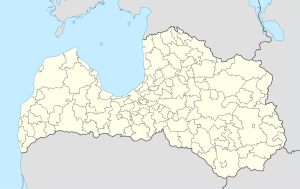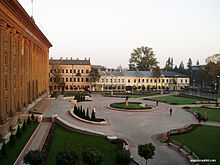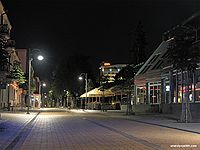- Daugavpils
-
Daugavpils — City — A view of Daugavpils in 1912. 
Flag
Coat of armsLocation in Latvia Coordinates: 55°53′N 26°32′E / 55.883°N 26.533°E Country  Latvia
LatviaTown rights 1275 Government - Mayor Žanna Kulakova Area - Total 72.48 km2 (28 sq mi) - Water 9.75 km2 (3.8 sq mi) Population - Total 102 496 - Density 1,414/km2 (3,662.2/sq mi) Time zone EET (UTC+2) - Summer (DST) EEST (UTC+3) Postal code LV-540(1–2); LV-540(4–5); LV-5410; LV-54(12–15); LV-54(17–20); LV-5422; LV-5465 Calling code +371 654 Number of city council members 15 Daugavpils (pronounced [ˈdaʊɡaʊpils] (
 listen)) is a city in southeastern Latvia, located on the banks of the Daugava River, from which the city gets its name. Daugavpils literally means "Daugava Castle". With a population of over 100,000, it is the second largest city in the country after the capital Riga, which is located some 230 km to its north-west. Daugavpils has a favorable geographical position as it borders Belarus and Lithuania (distances of 33 and 25 km respectively). It is located some 120 km from the Latvian border with Russia. Daugavpils is a major railway junction and industrial centre.
listen)) is a city in southeastern Latvia, located on the banks of the Daugava River, from which the city gets its name. Daugavpils literally means "Daugava Castle". With a population of over 100,000, it is the second largest city in the country after the capital Riga, which is located some 230 km to its north-west. Daugavpils has a favorable geographical position as it borders Belarus and Lithuania (distances of 33 and 25 km respectively). It is located some 120 km from the Latvian border with Russia. Daugavpils is a major railway junction and industrial centre.The city is surrounded by many lakes and nature parks.
Contents
Names
Historically, several names in various languages have identified Daugavpils. Some are still in use today.
- Belarusian: Даўгаўпілс (Daŭhaŭpils), Дзвінск (Dzvinsk),[nb 1] historically Дынабург (Dynaburh)
- Estonian: Väinalinn
- Finnish: Väinänlinna
- German: Dünaburg
- Latgalian: Daugpiļs
- Lithuanian: Daugpilis
- Polish: Dyneburg, Dźwinów, Dźwińsk, with Dźwińsk and Dyneburg the names still in use in Polish today
- Russian: Даугавпилс, Борисоглебск (Borisoglebsk 1656–1667), Двинcк (Dvinsk)
- Yiddish: דענעבורג (Dineburg)
Here is a chronology of name changes: Dinaburg (1275—1656) → Borisoglebsk (1656—1667) → Dinaburg (1667—1893) → Dvinsk (1893—1920) → Daugavpils (1920—today)
Climate
Climate of the city is moderate continental.
Climate data for Daugavpils Month Jan Feb Mar Apr May Jun Jul Aug Sep Oct Nov Dec Year Average high °C (°F) −3.6
(25.5)−2.6
(27.3)2.1
(35.8)10.3
(50.5)17.9
(64.2)21.5
(70.7)22.5
(72.5)21.6
(70.9)16.3
(61.3)9.8
(49.6)3.3
(37.9)−1
(30)9.8 Average low °C (°F) −9.7
(14.5)−9.9
(14.2)−6.5
(20.3)0.6
(33.1)6.1
(43.0)10.1
(50.2)11.8
(53.2)10.9
(51.6)7.2
(45.0)2.9
(37.2)−1.4
(29.5)−6.1
(21.0)1.3 Precipitation mm (inches) 37
(1.46)28
(1.1)32
(1.26)42
(1.65)52
(2.05)74
(2.91)79
(3.11)74
(2.91)69
(2.72)52
(2.05)51
(2.01)43
(1.69)633
(24.92)Source: World Weather Information Service [1] Demographics
As of 1 January 2011, the city had a population of 102 496.
History
The town's history began in 1275 when Dünaburg castle was built by the Livonian Order 20 km up the Daugava river from where Daugavpils is now situated. In 1561 it became part of the Polish–Lithuanian Commonwealth (see: Duchy of Livonia) and in 1566 became capital of the Inflanty Voivodeship, which existed until the First Partition of Poland. In 1577, Dünaburg castle was captured and destroyed by Russian tsar Ivan the Terrible. That same year, a new castle was built 20 km downriver. In 1582 Daugavpils was granted Magdeburg town rights. In the 17th century, during the Russo–Swedish War initiated by Alexis of Russia, the Russians captured Daugavpils, renamed the town Borisoglebsk and controlled the region for 11 years, between 1656 and 1667. Russia returned the area to Poland following the Treaty of Andrusovo.
From 1784 onwards, the city had a large and active Jewish population [3] among whom figured a number of prominent figures. According to the Russian census of 1897, out of a total population of 69,700, Jews numbered 32,400 (so around 44% percent).[4]
As part of the Russian Empire the city was called Dvinsk (1893–1920). The town was renamed Daugavpils in 1920 as part of an independent Latvia. The city was the site of the Battle of Daugavpils from 1919 to 1920. Daugavpils was part of the Soviet Union between 1940–41 and 1944–1991, and was occupied by the Nazis between 1941–44. The Nazis established the Daugavpils Ghetto where the town's Jews were forced to live. During the Cold War it was the site of the Lociki air base, 12 km northeast of the town itself.
On Friday, April 16, 2010, vice mayor Grigory Nemtsov of Daugavpils was shot dead in the center of the city. The crime remains unsolved but is likely to be connected to Nemtsov's controversial career as a politician.
Art, architecture, and culture
Daugavpils is an important cultural center in eastern Latvia. There are 22 primary and secondary schools, four vocational schools, and the Saules College of Art. More than 1,000 teachers and engineers graduate from Daugavpils Pedagogical University (now Daugavpils University) and the local branch of Riga Technical University annually.
The city theatre was restored a couple of years ago. There is also one cinema as well as other cultural institutions. The city exhibition center offers many cultural activities.
There are also several architectural, historical, and cultural monuments in Daugavpils. The most prominent is the Daugavpils fortress of the late 18th–19th centuries.
Historical centre
The historical centre of Daugavpils city is an architectural heritage of national importance (the construction work was carried out in the 19th century according to the project endorsed in St Petersburg in 1826). The historical centre is the greatest attraction of the city and one of the most successful examples of balancing the aspects of ancient and modern times. Daugavpils is one of the few cities in Latvia which can pride itself on a unified ensemble of both classic and eclectic styles. The cultural heritage of architectural, artistic, industrial, and historical monuments combined with the picturesque surroundings create the essence of Daugavpils’ image and endow it with a special charm.
Red brick buildings
Daugavpils is exceptionally rich in red brick buildings. This style was developed by many outstanding architects. In Daugavpils this variety of eclecticism is most widely represented in the buildings designed by Vilhelm Neimanis, an architect of the German origin, who was the chief architect of Daugavpils from 1878 to 1895. Bright examples of brick architecture are the buildings at 1/3 Saules Street and at 8 Muzeja Street. The shape-forming techniques typical of eclecticism that were applied in the façades of these buildings even many decades later make one appreciate and admire the striking accuracy of detail.
Airport
Daugavpils International Airport is located 12 km northeast of Daugavpils, near the village of Lociki. The airport is currently under development to allow both international and domestic passenger traffic, as well as international and domestic cargo transport and charter flights. It is expected to be operational by 2013.[5][6]
Sports
The football clubs Dinaburg FC and FC Daugava play at Celtnieks Stadium in Daugavpils. There is also a hockey team called DHK Latgale, which currently plays in the Latvian Hockey League. The Speedway Grand Prix of Latvia was hosted here between 2006 and 2009. Lokomotiv Daugavpils is a motorcycle speedway team based in Daugavpils who currently race in Polish First League (2nd division). In 2008 the construction of the Daugavpils Multifunctional Sports Complex was started and was completed in October 2009.
Notable residents
- Gotthard Kettler (1571–1587), last Master of the Livonian Order and the first Duke of Courland and Semigallia
- Meir Simcha of Dvinsk (1843–1926), rabbi
- the Rogatchover Gaon (1858–1936), rabbi
- Abraham Isaac Kook (1864–1935), rabbi, thinker, diplomat, mediator, scholar
- Grzegorz Fitelberg (1879–1953), composer and conductor
- Isaac Nachman Steinberg (1888–1957), writer, politician, co-founder of the Freeland League
- Solomon Mikhoels (1890–1948), actor and director
- Oskar Strok (1892–1976), composer
- Leonid Dobychin (1894–1936), writer
- Stanisław Swianiewicz (1899–1997), economist and historian
- Mark Rothko (1903–1970), abstract expressionist painter
- Władysław Raginis (1908–1939), officer
- Movsas Feigins (or Movša Feigins)(1908–1950), chess master
- Isser Harel (born Isser Halperin) (c.1912–2003)
- Grigory Nemtsov (1948–2010), Latvian journalist, businessman and politician.
- Ulyana Semenova (born 1952), basketball player
- Vitas (born 1979), Singer, Songwriter, Composer, Actor and Fashion designer
International relations
See also: List of twin towns and sister cities in LatviaTwin towns – Sister cities
Daugavpils is twinned with:
Notes
- ^ In Taraškievica it is spelled Дзьвінск (Dźvinsk).
References
- ^ "Weather Information for Daugavpils". World Weather Information Service. http://www.worldweather.org/044/c00173.htm. Retrieved 2008-12-01.
- ^ "Tabula: IS20. PASTĀVĪGO IEDZĪVOTĀJU NACIONĀLAIS SASTĀVS REĢIONOS UN REPUBLIKAS PILSĒTĀS GADA SĀKUMĀ". Data.csb.gov.lv. http://data.csb.gov.lv/Dialog/varval.asp?ma=IS0200&ti=IS20%2E+PAST%C2V%CEGO+IEDZ%CEVOT%C2JU+NACION%C2LAIS+SAST%C2VS+RE%CCIONOS+UN+REPUBLIKAS+PILS%C7T%C2S+GADA++S%C2KUM%C2&path=../DATABASE/Iedzsoc/Ikgad%E7jie%20statistikas%20dati/Iedz%EEvot%E2ji/&lang=16. Retrieved 2011-09-15.
- ^ "Jewish families of Dvinsk". jewishgen.org. http://www.jewishgen.org/databases/latvia/DvinskFamilies.htm. Retrieved 2008-07-12.
- ^ Joshua D. Zimmerman, Poles, Jews, and the politics of nationality, Univ of Wisconsin Press, 2004, ISBN 0299194647, Google Print, p.16
- ^ "Daugavpils |". Daugavpils.lv. http://www.daugavpils.lv/index.php?load=780&set_lang=en. Retrieved 2011-09-15.
- ^ "Daugavpils |". Daugavpils.lv. http://www.daugavpils.lv/?load=1&newsId=7858. Retrieved 2011-09-15.
External links
- Information portal (Russian)
- Information-entertaining portal (Russian)
Coordinates: 55°52′48″N 26°30′36″E / 55.880000°N 26.510000°E
- Daugavpils on wikitravel
- Daugavpils history (Latvian) (Russian)
- Jewish community (Russian) (English)
- Daugavpils news portal (Russian)
- Vishki,a shtetl
- Vishki,a shtetl in Latvia (English) (Russian)
- Population of Daugavpils by mother tongue in 1897
Republican cities and Municipalities of Latvia Republican cities: Municipalities: Aglona • Aizkraukle • Aizpute • Aknīste • Aloja • Alsunga • Alūksne • Amata • Ape • Auce • Ādaži • Babīte • Baldone • Baltinava • Balvi • Bauska • Beverīna • Brocēni • Burtnieki • Carnikava • Cēsis • Cesvaine • Cibla • Dagda • Daugavpils • Dobele • Dundaga • Durbe • Engure • Ērgļi • Garkalne • Grobiņa • Gulbene • Iecava • Ikšķile • Inčukalns • Ilūkste • Jaunjelgava • Jaunpiebalga • Jaunpils • Jēkabpils • Jelgava • Kandava • Kārsava • Kocēni • Koknese • Krāslava • Krimulda • Krustpils • Kuldīga • Ķegums • Ķekava • Lielvārde • Līgatne • Limbaži • Līvāni • Lubāna • Ludza • Madona • Mālpils • Mārupe • Mazsalaca • Mērsrags • Naukšēni • Nereta • Nīca • Ogre • Olaine • Ozolnieki • Pārgauja • Pāvilosta • Pļaviņas • Preiļi • Priekule • Priekuļi • Rauna • Rēzekne • Riebiņi • Roja • Ropaži • Rucava • Rugāji • Rundāle • Rūjiena • Salacgrīva • Sala • Salaspils • Saldus • Saulkrasti • Sēja • Sigulda • Skrīveri • Skrunda • Smiltene • Stopiņi • Strenči • Talsi • Tērvete • Tukums • Vaiņode • Valka • Varakļāni • Vārkava • Vecpiebalga • Vecumnieki • Ventspils • Viesīte • Viļaka • Viļāni • ZilupeCategories:- Daugavpils
- Cities in Latvia
- Republican cities of Latvia
- Populated places established in the 13th century
Wikimedia Foundation. 2010.









